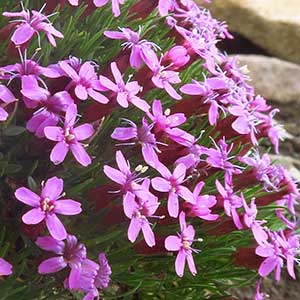Silene acaulis
Silene laciniata
moss campion, silène acaule
cardinal catchfly, Indian pink, Mexican campion, Mexican pink, Mexican pink or campion
1–several, straggling to erect, sometimes decumbent at base, simple or much-branched distally, 20–120 cm, puberulent or scabrous-pubescent, sometimes retrorse, often glandular distally, becoming glabrate proximally.
erect, leafy proximally, 3–6(–15) cm, old leaves persistent at base.
mostly basal, densely crowded and imbricate, sessile;
blade 1(–3)-veined, linear-subulate to lanceolate, 0.4–1(–1.5) cm × 0.8–1.5(–2) mm, margins cartilaginous, often ciliolate especially proximally, apex acute, glabrous to scabrous.
sessile or narrowed at base into pseudopetiole, blade pubescent on both surfaces;
proximal with blade lanceolate and oblanceolate, broadest distally or distal often reduced, cauline longest near mid stem, blade linear to lanceolate or elliptic, 1.5–10 cm × 2–30 mm.
solitary flowers.
from 1-flowered to simple dichotomy to compound and 3–5–many-flowered with elongate branches;
bracts small, linear-lanceolate, or resembling leaves.
2–40 mm.
elongate, much exceeding calyx.
bisexual or unisexual, all plants having both staminate and pistillate flowers, others having only pistillate flowers, subsessile or borne singly on peduncle;
calyx 10-veined, lateral veins absent, tubular to campanulate, (5–)7–10 mm, herbaceous, margins often purple tinged, dentate, sometimes ciliate, ± scarious, glabrous, lobes lanceolate to ovate, 1–2 mm;
petals bright pink, rarely white, limb unlobed to shallowly 2-fid, 2.5–3.5 mm, base tapered into claw, auricles and appendages poorly developed;
stamens exserted in staminate flowers, not so or aborted in pistillate flowers;
styles 3.
calyx green, 10-veined, broadly tubular, 12–25 × 4–8 mm in flower, narrower towards base, middle broadening to 6–13 mm in fruit, narrower at both ends, pubescent, glandular, lobes lanceolate, 2.5–5 mm, margins membranous or not, apex ± obtuse;
corolla scarlet, clawed, claw equaling or longer than calyx, limb lobed, often deeply so, lobes 4–6, linear, lanceolate, or oblong, small lateral teeth may be present, 6–15 mm, appendages inconspicuous, 1–2 mm, dentate;
stamens longer than corolla claw but shorter than lobes;
stigmas 3, equaling corolla.
3-locular, cylindric, equaling or to 2 times calyx, opening by 6 recurved teeth;
carpophore ca. 1 mm.
oblong to ovoid or broadly tubular, equaling calyx, opening by 6 ascending teeth;
carpophore 2–4 mm.
light brown, reniform, 0.8–1(–1.2) mm broad, dull, shallowly rugose.
reddish brown, broadly reniform, 1.7–2.3 mm, sides tuberculate, margins papillate.
= 24.
Silene acaulis
Silene laciniata
Silene acaulis is a variable species, and most workers have recognized infraspecific taxa in North America: subsp. acaulis (subsp. exscapa and subsp. arctica), which is predominantly arctic; and subsp. subacaulescens, which extends down the Rocky Mountains from Alaska to Arizona and New Mexico. In subsp. acaulis, the leaves are flat and short and the flowers are subsessile and smaller in size. Subspecies subacaulescens is typically a larger, less-compact plant with longer, narrower leaves and larger, pedunculate flowers. However, in many populations, these two variants are poorly differentiated, and in others both occur together, connected by intermediates.
Silene acaulis is widely distributed in arctic and alpine Europe.
(Discussion copyrighted by Flora of North America; reprinted with permission.)
Subspecies 3 (3 in the flora).
The large, beautiful scarlet flowers of Silene laciniata are bird- and butterfly-pollinated. The species occurs in three forms. Subspecies laciniata has narrow leaves, much-branched and many-flowered, open inflorescences, and oblong capsules. Subspecies californica has ovate to lanceolate leaves, few-flowered inflorescences, and ovoid capsules. These two entities both occur in California and Mexico. Although they are usually distinguishable, apparent intermediates occur. The third entity is subsp. greggii, which occurs in Arizona, southwestern Texas, and Mexico. It combines characters of the other two subspecies, having broader leaves, a branched and many-flowered open inflorescence, and a capsule of intermediate shape.
(Discussion copyrighted by Flora of North America; reprinted with permission.)
1. Inflorescences poorly developed, usually 1-3(-5)-flowered; stems straggling, sparsely branched, leafy throughout; distal leaf blades and bracts lanceolate to ovate-lanceolate; capsules ovoid; fruiting calyces obovate to turbinate, more than 1/ 2 as broad as long | subsp. californica |
1. Inflorescences well-developed, (3-)5+-flowered; stems erect or ascending, sometimes with decumbent base, branched distally; distal leaves reduced, blade linear or lanceolate to elliptic; capsules oblong or broadly tubular; fruiting calyces less than 1/ 2 as broad as long | → 2 |
2. Distal leaf blades linear to lanceolate, proximal leaf blades lanceolate to oblanceolate; California, Mexico | subsp. laciniata |
2. Distal leaf blades lanceolate to elliptic, proximal leaf blades oblanceolate, often broadly so; Arizona to sw Texas, s into Mexico | subsp. greggii |


